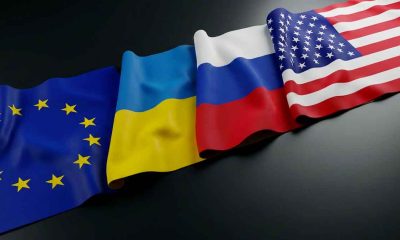International News
Just a Week After Trump’s ‘Liberation Day’ Tariffs, Judgement Day Arrived

After insisting for a week that tariffs against the world would never be reversed, the White House blinked on Wednesday afternoon. President Donald Trump announced he was “pausing” most of the tariffs issued last week for 90 days and increased tariffs on China to 145%. The stock market went on to have its best days in history, with the Dow Jones jumping 7.7%, closing at 40,601.64.
What caused Judgement Day to arrive only seven days, almost to the hour, when “Liberation Day” was announced?
U.S. Treasury Yields Surged, Setting off Alarms
Financial and economic experts were watching the $29 trillion in U.S. Treasury bonds with growing dismay. On Tuesday morning, the yield on 10-year bonds had gone vertical. In the span of 36 hours, the rate crossed 4.0% and broke through 4.5%. Holders of U.S. treasuries were dumping their bonds, and it was on a wide scale and accelerating.
Japan was the biggest seller, but other nations were involved. Sitting on the sidelines was China, which holds $760 billion in treasury bonds. If the White House ignored this blinking red warning light, yields would continue to increase, and eventually, new sales of treasury bonds would start to decline. The world was saying it had lost confidence in the U.S. leadership at the most fundamental level.
Wednesday Morning was Seen as Judgement Day
Before the markets opened on Wednesday, financial experts and economists saw 9 April as “judgement day.” They expected the White House to do one of two things: pause or end tariffs due to the accelerating sell-off of U.S. treasuries, or continue to insist that the tariffs enacted on “Liberation Day” would remain in place. One path would signal to the world that the White House was getting the message, while the other path led to potentially irreversible economic damage.
What Caused the Accusations of Market Manipulation
Since 3 April, Trump and his surrogates have repeatedly advised investors to ignore the plunging stock markets and buy into the dip. On 8 April, a tweet stating that the Trump administration would announce a 90-day pause on tariffs sent the stock market soaring. A few hours later, the White House declared the tweet was false, vehemently denying there were any discussions on pausing tariffs, sending the market into another crash.
On Wednesday, approximately four hours before President Trump announced the “pause” on tariffs, he wrote on his personal social media platform, Truth Social, “THIS IS A GREAT TIME TO BUY!!! DJT [Emphasis Trump – Ed.]” At 1:30 PM Eastern Time, he announced the change in policy, and the stock market soared. In the minutes before his announcement, there was a surge in activity among equity traders.
However, during his announcement, Trump referenced the bond markets and said that people were clearly showing signs of being “afraid.”
Just the day before, he called those selling stocks “PANICANS.” That accusation aged like room temperature milk on a summer day.
What Were the Unseen Drivers
For those watching from the 50,000-foot view, there were many indications that the Trump administration would have to do something. The policy wasn’t just causing economic damage. It was creating political damage, too.
Over the weekend, Presidential Counselor and tariff plan architect Peter Navarro hit billionaire Elon Musk after he called for a tariff-free zone with Europe, calling Musk a “car assembler.” On Monday, Musk wrote that Navarro was a “moron” and “dumber than a sack of bricks.” The White House tried to spin the public spat as “boys will be boys.” It was reported that on Tuesday, Musk was a 100% “PANICAN,” privately urging the White House to fire Navarro.
Additionally, multiple high-profile podcasters and influencers started turning on the White House, Navarro, and each other. On the Sunday morning talk show circuit and into Tuesday, several Republican senators and representatives called for the White House to reconsider its tariff policy.
What Happened on Thursday
On Thursday, the Dow lost 2.5%, closing at 39,593.66 (-1,014.79), as investors remained glum about Chinese tariffs and others conducted profit taking. Speaking with CNN, Navarro laughed off today’s decline, calling the suggestion that the market volatility of the last week was caused by Trump’s governing style “pure spin.”
“You had the highest rise in stock market history yesterday,” Nararro said, “Of course, there’s gonna be a little pullback…It’s just normal retracement after a big day. It’s no big deal.”
There were mixed signs from U.S. treasuries in today’s data, after closing at 4.392% on Wednesday, the yield on 10-year bonds climbed to 4.425%. However, there was still strong demand in today’s 30-year bond auction, with $22 billion sold with yields around 4.83%.
Trump was true to himself, telling the press that tariffs could be brought back sooner if countries refuse to negotiate with the U.S., adding that he could extend the current pause beyond 90 days. “We’ll have to see what happens at the time.”
Did Trump Conduct Market Manipulation
In our assessment, the optics are bad, but the truth matters. It is a stretch to conclude this was planned market manipulation. The financial management advisors and economists we talked to universally said the data on Wednesday morning contained the signs that something had to happen.
The White House’s new tariff plan doesn’t help Amazon (AMZN), Walmart (WMT), Boeing (BA), Apple (APPL), Alphabet (GOOG), or Microsoft (MSFT), their investors, or their billionaire founders and leaders. This was a strange way to “help” friends and allies.
Disclosures: The author of this story owns shares of Amazon (AMZN), Microsoft (MSFT), and Apple (APPL). He is also a former employee of Amazon, last working for the company in 2016, and Microsoft, last working as a consultant in 2022. They have not conducted any trades in AMZN, MSFT, or APPL in 2025.










